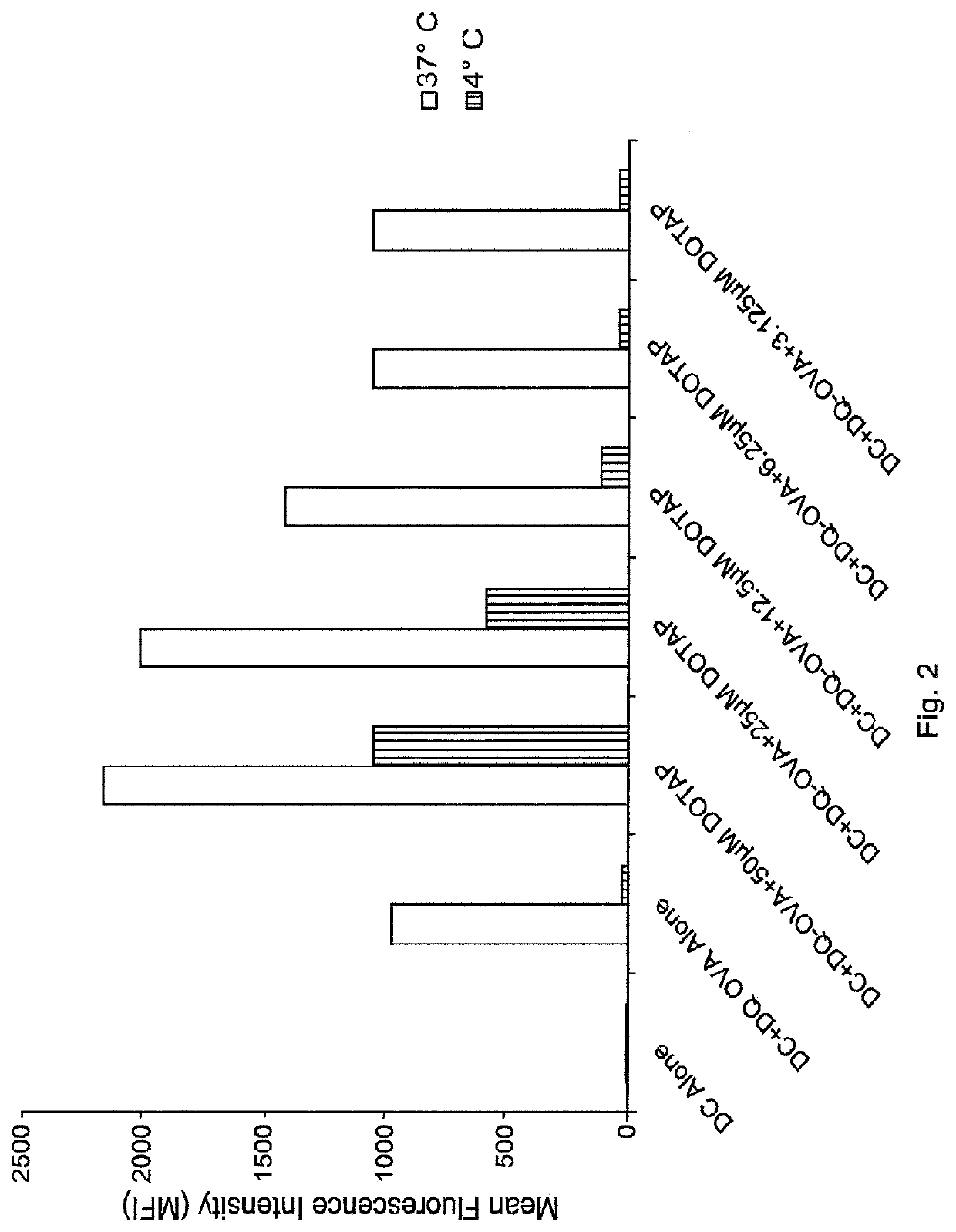Lipids as synthetic vectors to enhance antigen processing and presentation ex-vivo in dendritic cell therapy
a dendritic cell and synthetic vector technology, applied in the field of dendritic cell therapy, can solve the problems of ineffective proteasome pathway, cumbersome approach, critical limiting factor in the success of dc vaccine application, etc., and achieve low treg cell level, high level of antigen specific cd8+, and effective treatment of the patient for cancer
- Summary
- Abstract
- Description
- Claims
- Application Information
AI Technical Summary
Benefits of technology
Problems solved by technology
Method used
Image
Examples
example 1
Effect of Cationic Lipids on Antigen Uptake by Dendritic Cells
[0112]In order to determine the effect of cationic lipids on the uptake of protein antigen, mouse bone marrow derived dendritic cells (BMDCs) were pulsed with Alexa Fluor®647-OVA conjugate and quantified ovalbumin uptake by BMDCs using flow cytometry. Briefly, 2×106cells / ml BMDCs were incubated at 37° C. for 10-60 minutes in serum free RPMI 1640 cell culture media containing 20 μg / ml ovalbumin (Ovalbumin Alexa Fluor® 647 conjugate; life technologies, cat #O34784) and 50 μM cationic lipid (RDOTAP) or 280 mM sucrose diluent. Cells were washed after pulsing to remove non-cell associated ovalbumin and fixed with 1% formaldehyde for flow cytometer analysis. The ovalbumin uptake was quantified using BD LSR II flow cytometer. As shown in FIG. 1, cationic lipids were significantly increased the protein uptake by BMDC at all time points measured. Furthermore, protein uptake occurred very rapidly in presence of cationic nanoparticl...
example 2
Effect of Cationic Lipids on Antigen Processing by Dendritic Cells and Epithelial Cells
[0113]In order to determine the effects of cationic lipids on antigen uptake and processing by dendritic cells ex-vivo, a fluorescent ovalbumin protein called DQ-OVA was used. DQ-OVA is non-fluorescent when intact, but emits both red and green fluorescence when the protein is degraded. BMDC were incubated at 37° C. or 4° C. for 1 hr with DQ-OVA alone, or DQ-OVA mixed with different concentrations of the cationic lipid DOTAP. The cells were then washed, fixed, and stained with fluorescent antibodies to CD11c, a marker for dendritic cells. Cells were then analyzed on an LSRII flow cytometer in both red and green fluorescent channels.
[0114]Results in FIG. 2 show that BMDC incubated with fluorescent DQ-OVA in media alone showed enhanced fluorescence at 37° C. indicating uptake and processing. This represents the well-known mannose receptor mediated uptake of OVA by DC. DOTAP enhances antigen uptake an...
example 3
Comparison of Effect of Cationic Lipids on Antigen Processing and Endosomal Entry with Known Adjuvants
[0117]In order to determine whether lipid adjuvants could mediate the same effect as R-DOTAP, BMDC were incubated with DQ-OVA in media alone or with R-DOTAP as described for FIG. 1. In addition, BMDC were incubated under identical conditions with the potent lipid adjuvant lipopolysaccharide (LPS). Mouse bone marrow DC were incubated in the presence of fluorescent DQ-OVA for one hour at either 37° C. or 40° C / azide in the presence of 25 μM DOTAP nanoparticles, 10 μg / ml LPS or media alone, and analyzed by flow cytometry. As shown in FIG. 1, DQ-OVA was actively taken up and processed by DC in the absence of R-DOTAP, but the uptake was greatly enhanced in the presence of R-DOTAP manifested as a strong increase in red fluorescence. In contrast, no such enhancement was observed with LPS treatment, as shown in FIG. 4. Monophorphoryl lipid-A (MPL) is a lower toxicity derivative of LPS that ...
PUM
| Property | Measurement | Unit |
|---|---|---|
| diameter | aaaaa | aaaaa |
| size | aaaaa | aaaaa |
| volume | aaaaa | aaaaa |
Abstract
Description
Claims
Application Information
 Login to View More
Login to View More - R&D
- Intellectual Property
- Life Sciences
- Materials
- Tech Scout
- Unparalleled Data Quality
- Higher Quality Content
- 60% Fewer Hallucinations
Browse by: Latest US Patents, China's latest patents, Technical Efficacy Thesaurus, Application Domain, Technology Topic, Popular Technical Reports.
© 2025 PatSnap. All rights reserved.Legal|Privacy policy|Modern Slavery Act Transparency Statement|Sitemap|About US| Contact US: help@patsnap.com



